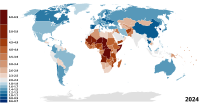
Photo from wikipedia
Objectives: The outbreak of COVID-19 in Massachusetts may have reduced ambulatory care access. Our study aimed to quantify this impact among populations with severely uncontrolled diabetes and hypertension; these populations… Click to show full abstract
Objectives: The outbreak of COVID-19 in Massachusetts may have reduced ambulatory care access. Our study aimed to quantify this impact among populations with severely uncontrolled diabetes and hypertension; these populations are at greatest risk for adverse outcomes caused by disruptions in care. Methods: We analyzed multidisciplinary ambulatory electronic health record data from MDPHnet. We established 3 cohorts of patients with severely uncontrolled diabetes and 3 cohorts of patients with severely uncontrolled hypertension using 2017, 2018, and 2019 data, then followed each cohort through the subsequent 15 months. For the diabetes cohorts, we generated quarterly counts of glycated hemoglobin A1c (HbA1c) tests. For the hypertension cohorts, we generated monthly counts of blood pressure measurements. Finally, we assessed telehealth use among the 2019 diabetes and hypertension cohorts from January 2020 through March 2021. Results: HbA1c testing and blood pressure monitoring dropped considerably during the pandemic compared with previous years. In the 2019 diabetes cohort, HbA1c measurements declined from 44.0% in January–March 2020 (baseline) to 15.9% in April–June 2020 and was 11.8 percentage points below baseline in January–March 2021. In the 2019 hypertension cohort, blood pressure measurements declined from 40.0% in January 2020 to 4.5% in April 2020 and was 23.5 percentage points below baseline in March 2021. Telehealth use increased precipitously during the pandemic but was not uniform across subpopulations. Conclusions: Access to selected diabetes and hypertension services declined sharply during the pandemic among populations with severely uncontrolled disease. Although telehealth is an important strategy, ensuring equity in access is essential. Telehealth hybrid models can also minimize disruptions in care.
Journal Title: Public Health Reports
Year Published: 2022
Link to full text (if available)
Share on Social Media: Sign Up to like & get
recommendations!